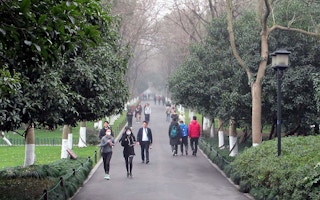As the coronavirus outbreak shutters gyms, malls and swimming pools, residents from Los Angeles to Bangkok are heading to parks and open spaces during lockdowns, highlighting their vital role in protecting health and wellbeing, urban experts said.
More than 377,000 people have been infected by the coronavirus across the world and 16,500 have died, according to a Reuters tally.
With strict lockdown measures in hundreds of cities across the world, residents are often still allowed to go outside to run, walk or cycle once a day, as long as they practise social distancing, or keep two metres (6.5 ft) from each other.
The measures show how crucial open spaces are in cities, said Diane Archer, a research fellow at the Stockholm Environment Institute (SEI) in Bangkok, where she often runs in a neighbourhood park.
“We know the important role that green spaces and trees can play in shade and cooling, reducing flood risk and maintaining biodiversity,” she told the Thomson Reuters Foundation on Tuesday.
“But these spaces are important for relaxation and exercise, too. A walk in the park can be vital to mental health and reducing stress levels in this challenging time,” she said.
City dwellers tend to live longer if they are in leafy neighbourhoods, according to a study last year that showed a 10 per cent increase in greenery led to an average 4 per cent reduction in premature deaths.
“
This epidemic has underlined the importance of designing cities for health and wellbeing.
Kotchakorn Voraakhom, landscape architect
In the northeastern Thai city of Udon Thani, a study by SEI found that people had their lowest stress levels when they were in a park, Archer said.
Research published earlier this year by Britain’s University of Manchester showed that older people’s health is linked to the quantity, quality and proximity of local green and blue spaces.
Such spaces are “critical determinants of health and wellbeing”, said Sarah Lindley, a professor of geography at the university’s School of Environment, Education and Development.
“Urban green spaces reduce environmental stresses and improve recovery. They actively promote health as they have better general air quality, better temperature regulation and lower noise levels,” she said.
“In the current crisis situation, social functions need to be greatly reduced, but the intrinsic value of these places - and many of their beneficial functions - still remain.”
But green spaces are not equally distributed or easily accessible by all, and wealthier people may have more options when choosing greener places to live, Lindley said.
Urban sprawl
Almost 70 per cent of the world’s population will be living in cities by 2050, according to estimates by the United Nations, mainly in Africa and Asia.
Poorer countries in these regions usually lack sufficient green spaces, as expanding populations put pressure on land for offices, homes and roads.
But urban residents are rallying to preserve green spaces.
“Urban sprawl is part of the reason why we are in this situation,” said landscape architect Kotchakorn Voraakhom in Bangkok, pointing to the rapid deforestation that scientists say has led to virus outbreaks.
“Especially in high-density cities where homes are small, and there are many people living in informal settlements - where can they go if there are no parks?”
“This epidemic has underlined the importance of designing cities for health and wellbeing,” she said.
This story was published with permission from Thomson Reuters Foundation, the charitable arm of Thomson Reuters, that covers humanitarian news, climate change, resilience, women’s rights, trafficking and property rights. Visit http://news.trust.org/climate.














